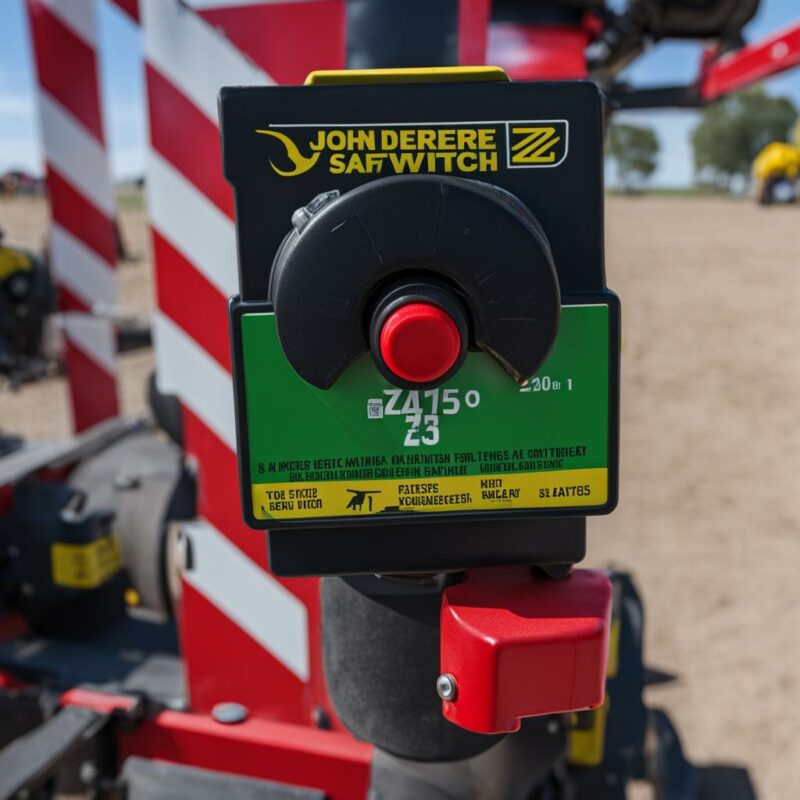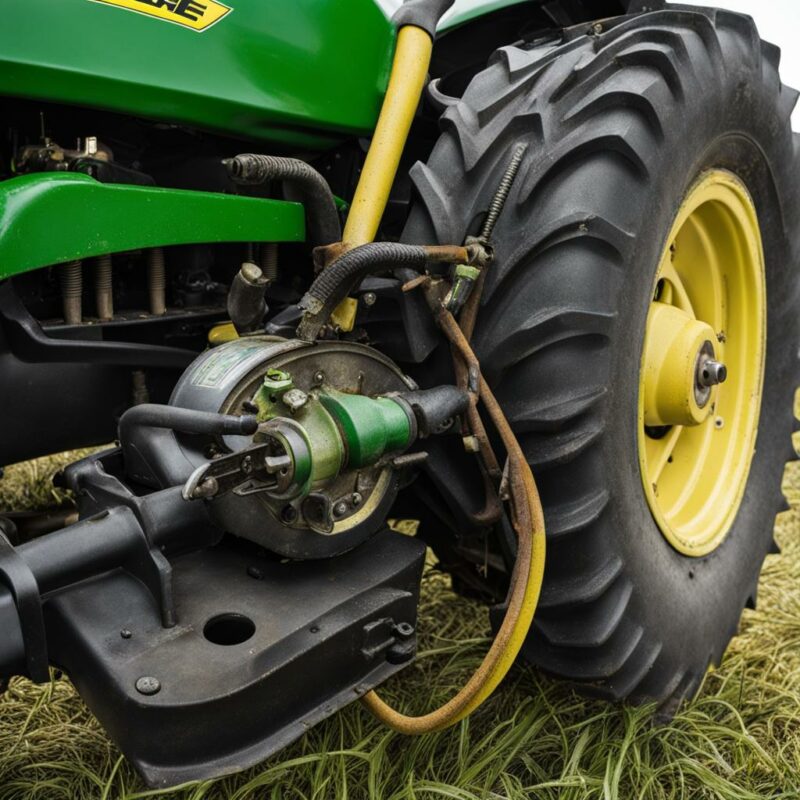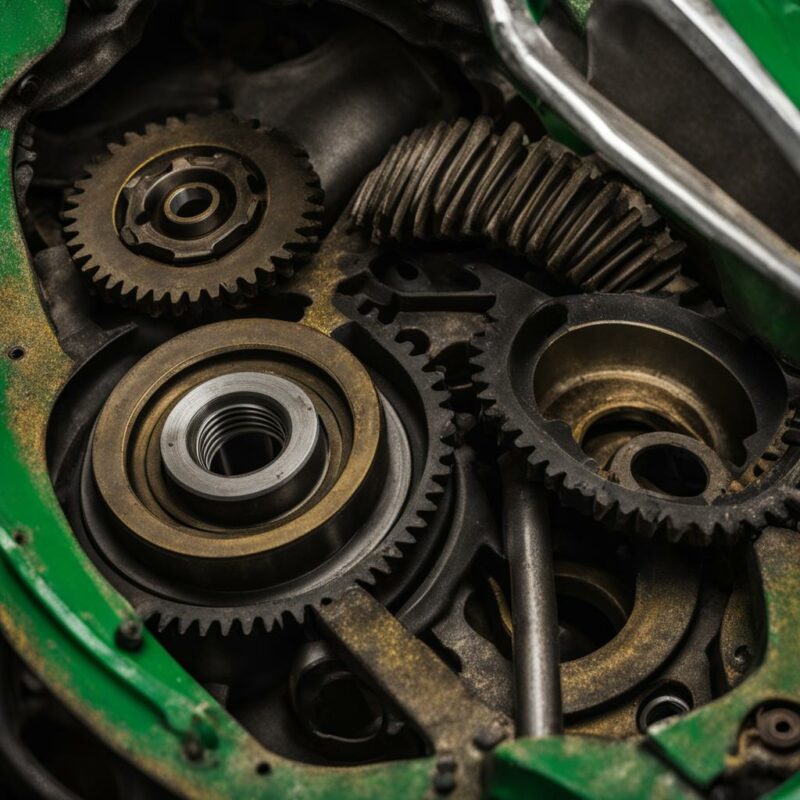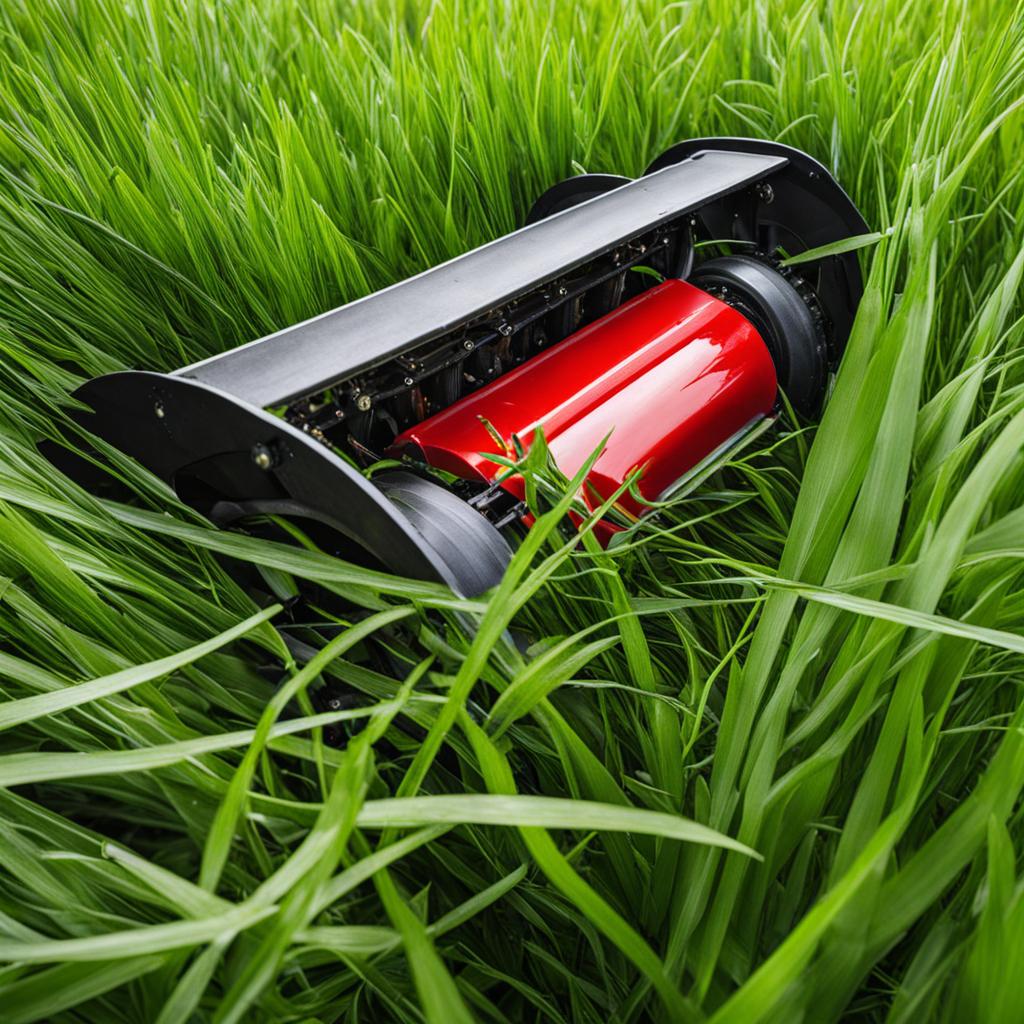The John Deere Z425 is a popular lawn mower model known for its durability and performance. However, like any machine, it can have its fair share of problems. In this article, we will explore the common issues that owners of the John Deere Z425 may encounter and provide solutions to fix them.
Key Takeaways
- Owners of the John Deere Z425 may encounter various problems such as starting difficulties, steering issues, and engine problems.
- Troubleshooting these problems can help resolve issues and get the mower back in top shape.
- Regular maintenance and following proper operating procedures can prevent future problems with the John Deere Z425.
- By understanding the common issues and their solutions, owners can enjoy the reliable performance of their John Deere Z425 mower.
- If unsure about fixing a problem, it is recommended to consult a professional for assistance.
6 Most Common John Deere Z425 Problems and the Solutions
While using the John Deere Z425, owners may face a few common problems. These include engine issues, transmission problems, starting difficulties, deck problems, electrical malfunctions, and steering troubles. In this section, we will discuss each of these problems in detail and provide effective solutions to resolve them.
Engine Problems
One of the most common issues with the John Deere Z425 is engine problems. These can manifest in various ways, such as excessive vibration, steering issues, or the emission of smoke. Engine problems can be caused by factors such as dirty air filters, low oil levels, or faulty spark plugs. To fix these issues, it is important to regularly clean or replace air filters, maintain proper oil levels, and inspect and replace spark plugs as needed.
Transmission Problems
Transmission problems can also occur in the John Deere Z425, leading to issues such as overheating or low fluid levels. These problems can be caused by factors like dirty or worn-out transmission filters, low or contaminated fluid, or damaged drive belts. To address these problems, owners should regularly inspect and clean the transmission filters, check fluid levels and quality, and replace any damaged drive belts.
Starting Difficulties
Starting problems are another common issue with the John Deere Z425. These can be caused by various factors, including dirty carburetors, open chokes, or blocked fuel filters. To resolve these issues, owners should check and clean carburetors, ensure that chokes are functioning properly, and replace any clogged fuel filters.
Deck Problems
Deck problems can affect the cutting performance of the John Deere Z425. These issues can include uneven deck heights, damaged blades, or problems with the belt. To address deck problems, owners should regularly inspect and adjust deck heights, replace damaged blades, and ensure that the deck belt is in good condition.
Electrical Malfunctions
Electrical malfunctions can cause various issues with the John Deere Z425, such as problems with the ignition system or malfunctioning safety switches. These issues can be caused by factors such as loose connections, damaged wires, or faulty switches. To fix electrical malfunctions, owners should inspect and secure all electrical connections, replace any damaged wires, and test and replace any faulty switches.
Steering Troubles
Steering problems can also arise in the John Deere Z425, including a loose latch or hydraulic pump issues. These problems can be caused by factors like loose or damaged steering components or low hydraulic fluid levels. To resolve steering troubles, owners should inspect and tighten all steering components, check and refill hydraulic fluid levels, and replace any damaged parts as necessary.
By addressing these common problems and following the recommended solutions, owners of the John Deere Z425 can keep their lawn mower in optimal condition, ensuring reliable performance for years to come.
Starting Problem
One common problem that owners may face with the John Deere Z425 is difficulty in starting the mower. This could be caused by various factors such as contaminated fuel, a stuck air strainer, or a dirty air-box. When the fuel is contaminated, it can clog the carburetor and prevent the engine from starting smoothly. Similarly, a stuck air strainer or a dirty air-box can restrict the airflow, resulting in starting issues.
To troubleshoot the starting problem, begin by checking the fuel quality. Make sure to use clean and fresh fuel without any impurities. If the fuel is contaminated, drain the tank and refill it with fresh fuel. It is also recommended to clean or replace the fuel filter to ensure proper fuel flow.
Next, inspect the air strainer and air-box for any obstructions or dirt buildup. Clean or replace them as necessary. Additionally, check the spark plug and ensure it is clean and properly gapped. If the spark plug is damaged or worn out, replace it with a new one.
By following these troubleshooting steps, you can resolve the starting problem with your John Deere Z425 and ensure smooth and reliable operation.
Steering Problem
One of the common issues that owners may encounter with the John Deere Z425 is steering problems. These problems can manifest as a loose latch or hydraulic pump issues, affecting the maneuverability of the mower. If left unresolved, steering problems can impact the overall performance and efficiency of the machine.
To troubleshoot and fix steering problems in the John Deere Z425, follow these steps:
- Inspect the latch mechanism for any signs of wear or damage. Tighten any loose components or replace the latch if necessary.
- Check the hydraulic pump for proper functioning. Ensure that it is receiving sufficient hydraulic fluid and that there are no leaks or blockages in the system.
- If the steering problems persist, consult the owner’s manual or seek professional assistance to diagnose and repair the issue.
By addressing steering problems promptly, owners can ensure smooth and precise steering performance, allowing them to effectively navigate their lawn and achieve optimal mowing results.
Malfunctioning of Safety Switch
The safety switch is an important component of the John Deere Z425 mower, responsible for ensuring safe operation. However, like any mechanical part, the safety switch can sometimes malfunction, leading to issues with the mower’s performance and functionality.
There are several possible reasons behind a safety switch problem in the John Deere Z425. It could be due to a faulty switch itself, loose connections, or wiring issues. In some cases, debris or moisture may also affect the switch’s functionality.
To troubleshoot a safety switch problem in the John Deere Z425, you can follow these steps:
- Check the connections: Ensure that all the connections related to the safety switch are secure and tight. If there are any loose connections, tighten them properly.
- Inspect the switch: Examine the safety switch for any visible signs of damage or wear. If you notice any issues, such as corrosion or broken components, it may be necessary to replace the switch.
- Clean the switch: If the safety switch is dirty or covered in debris, carefully clean it using a soft brush or compressed air. Ensure that the switch is completely dry before reassembling it.
- Test the switch: Once the connections are secure and the switch is clean, test its functionality. Check if the mower starts and stops as expected when engaging or disengaging the switch.
By following these troubleshooting steps, you can effectively diagnose and fix safety switch problems in the John Deere Z425. However, if the issue persists or you are unsure about performing the troubleshooting, it is recommended to consult a professional for further assistance.

Engine Problem
The engine is a crucial component of the John Deere Z425, and like any engine, it can develop problems over time. Understanding common engine issues and knowing how to troubleshoot and fix them can help keep your mower running smoothly. Here are some of the most common engine problems that owners of the John Deere Z425 may encounter:
- Engine Vibration: Excessive engine vibration can indicate a problem with the engine’s balance or a damaged component. Inspect the engine mounts, blades, and pulleys for any signs of wear or damage. Replace any faulty parts and ensure that all connections are secure.
- Steering Issues: If your mower’s engine is experiencing difficulty in turning smoothly, it may be due to a problem with the steering system. Check the steering gear, linkage, and wheel alignment. Adjust or replace any worn or damaged parts as necessary.
- Smoke from the Exhaust: Smoke coming from the exhaust can be a sign of an engine problem. Blue smoke indicates burning oil, which could be caused by worn piston rings or a faulty valve seal. White smoke may indicate a coolant leak, while black smoke suggests an overly rich fuel mixture. Consult a professional technician for a proper diagnosis and repair.
To troubleshoot and fix engine problems in your John Deere Z425, follow these steps:
- Perform Regular Maintenance: Regularly check and change the engine oil, air filter, and spark plug according to the manufacturer’s recommendations. This helps ensure the engine operates at its best and minimizes potential problems.
- Inspect and Clean the Engine: Inspect the engine for any signs of leaks, loose connections, or debris accumulation. Clean the engine components using a brush or compressed air to remove dirt and debris that can affect performance.
- Seek Professional Help: If you are unable to diagnose or fix the engine problem on your own, it is recommended to take your John Deere Z425 to a certified technician or authorized service center for further inspection and repair.
By addressing engine problems promptly and following proper maintenance procedures, you can ensure that your John Deere Z425 remains in top condition and continues to deliver excellent performance.
| Engine Problem | Troubleshooting Steps | Repair Solutions |
|---|---|---|
| Engine Vibration | – Inspect engine mounts, blades, and pulleys – Replace faulty parts – Secure all connections |
– Replace worn or damaged components – Ensure proper balance |
| Steering Issues | – Check steering gear, linkage, and wheel alignment – Adjust or replace worn or damaged parts |
– Repair or replace faulty steering components – Align wheels properly |
| Smoke from the Exhaust | – Consult a professional technician for diagnosis – Check for burning oil, coolant leaks, or rich fuel mixture |
– Replace worn piston rings or valve seals – Repair coolant leaks – Adjust fuel mixture |

Clutch PTO Problem
The clutch PTO (Power Take-Off) is a crucial component in the John Deere Z425 that enables the mower’s blades to engage and disengage. However, some owners may encounter issues with the clutch PTO, such as slipping or disengagement. These problems can affect the mower’s overall performance and efficiency. In this section, we will explore the common causes of clutch PTO problems and provide troubleshooting tips to help you fix them effectively.
One possible cause of clutch PTO problems is a worn-out clutch plate. Over time, the clutch plate can become worn or damaged, resulting in slipping or disengagement. To fix this issue, you will need to replace the clutch plate with a new one. Additionally, inadequate lubrication can cause the clutch PTO to malfunction. Regularly inspect and lubricate the clutch components to ensure smooth operation.
Another common cause of clutch PTO problems is a faulty clutch cable. The cable may become stretched or frayed, preventing proper engagement of the clutch. In such cases, you will need to replace the clutch cable with a new one to restore functionality. Additionally, check for any obstructions or debris in the clutch mechanism that may be causing it to malfunction.
| Common Causes of Clutch PTO Problems | Troubleshooting Steps |
|---|---|
| Worn-out clutch plate | 1. Replace the clutch plate with a new one |
| Inadequate lubrication | 1. Inspect and lubricate clutch components regularly |
| Faulty clutch cable | 1. Replace the clutch cable with a new one |
| Obstructions or debris in clutch mechanism | 1. Check for any obstructions or debris and clean if necessary |
By following these troubleshooting steps, you can effectively resolve clutch PTO problems in your John Deere Z425. Regular maintenance and proper care of the clutch components will help ensure optimal performance and extend the lifespan of your mower.

Remember to consult the user manual or seek professional assistance if you are unsure about any repairs or maintenance procedures. Taking proper care of your John Deere Z425 will help you enjoy a smooth mowing experience and keep your lawn looking pristine.
Hydraulic Issues
Hydraulic issues can occur in the John Deere Z425, causing disruptions in the mower’s performance. Some common problems include loose connections, contamination of hydraulic fluid, and faulty hoses. These issues can lead to decreased efficiency and potential damage to the mower. It is important to address hydraulic problems promptly to ensure smooth operation and prevent further complications.
To troubleshoot hydraulic problems in the John Deere Z425, first check for any loose connections in the hydraulic system. Tighten any loose fittings or connections to ensure a secure seal. Next, inspect the hydraulic fluid for signs of contamination. Contaminated fluid can lead to reduced performance and component failure. If contamination is detected, drain and replace the fluid following the manufacturer’s recommendations.
If the hydraulic hoses in the John Deere Z425 are damaged or worn, they should be replaced. Damaged hoses can lead to leaks and loss of hydraulic power. It is important to use high-quality replacement hoses and ensure proper installation to prevent future issues. Regularly inspecting and maintaining the hydraulic system will help prevent problems and extend the lifespan of the mower’s components.
| Common Hydraulic Issues | Troubleshooting Steps |
|---|---|
| Loose connections | Tighten all fittings and connections |
| Contaminated hydraulic fluid | Drain and replace fluid following manufacturer’s recommendations |
| Faulty hydraulic hoses | Replace damaged hoses with high-quality replacements |
By addressing hydraulic issues in the John Deere Z425 promptly and following proper maintenance procedures, owners can ensure optimal performance and longevity of their mower. Regular inspection and maintenance of the hydraulic system will help prevent future problems and keep the mower running smoothly for years to come.
Transmission Issues
Another common problem that owners of the John Deere Z425 may encounter is transmission issues. The transmission is responsible for transferring power from the engine to the wheels, allowing the mower to move forward or backward. When the transmission malfunctions, it can result in poor performance and difficulty in maneuvering the mower.
Troubleshooting the transmission problem requires identifying the root cause. Common causes of transmission issues in the John Deere Z425 include overheating, low fluid level, or worn-out transmission belts. To diagnose the problem, owners can start by checking the transmission fluid level and inspecting the belts for any signs of wear or damage.
If the fluid level is low, owners should top it up with the recommended transmission fluid. If the fluid is dirty or discolored, it may be necessary to drain and replace it. In the case of worn-out transmission belts, they should be replaced to ensure proper power transfer and smooth operation.
Regular maintenance and periodic inspection of the transmission can help prevent issues and prolong its lifespan. Following the manufacturer’s guidelines for fluid changes and belt replacements is essential to keep the transmission in good working condition.
| Transmission Issues | Troubleshooting | How to Fix |
|---|---|---|
| Overheating | Check for blocked cooling fins, low fluid level | Clean cooling fins, top up fluid level, ensure proper ventilation |
| Low Fluid Level | Inspect for leaks, check fluid level | Repair leaks, top up fluid level with recommended transmission fluid |
| Worn-out Transmission Belts | Inspect belts for wear, cracks, or damage | Replace worn-out belts with new ones |
By addressing transmission issues promptly and following the recommended troubleshooting steps, owners can resolve problems related to the transmission and ensure smooth operation of their John Deere Z425 mower.

Carburetor Problems
The carburetor is a vital component of the John Deere Z425 mower, responsible for mixing fuel and air to create the combustible mixture needed for the engine to function properly. However, over time, carburetor problems can arise, leading to issues with the mower’s performance. Here, we will explore common carburetor problems that Z425 owners may encounter, and provide troubleshooting tips and solutions to fix them.
Common Carburetor Problems
- Dirty Carburetor: A dirty carburetor can cause a variety of issues, including rough idling, poor acceleration, and engine stalling.
- Faulty Needle Valves: Needle valves regulate the flow of fuel into the carburetor. If they become damaged or worn, fuel may not flow properly, leading to engine performance problems.
- Dirt Build-up: Dirt and debris can accumulate in the carburetor, blocking fuel passages and hindering the proper functioning of the mower.
Troubleshooting and Solutions
To address carburetor problems in the John Deere Z425, follow these troubleshooting steps:
- Step 1: Clean the Carburetor
Start by removing the carburetor from the engine and cleaning it thoroughly. Use a carburetor cleaner to remove any dirt, debris, or varnish that may have built up. Pay close attention to the passages and jets, ensuring they are clear and free from blockages. - Step 2: Check the Needle Valves
Inspect the needle valves for wear or damage. Replace them if necessary. Ensure that they are properly adjusted to control the fuel flow into the carburetor. - Step 3: Replace the Fuel Filter
A clogged or dirty fuel filter can contribute to carburetor problems. Replace the fuel filter regularly to ensure a clean fuel supply. - Step 4: Use Clean and Quality Fuel
Ensure that you are using clean and high-quality fuel. Contaminated or old fuel can cause carburetor issues. Consider using fuel additives to keep the carburetor clean. - Step 5: Regular Maintenance
Keep up with regular maintenance tasks such as air filter cleaning or replacement, spark plug inspection, and oil changes. These measures will help prevent carburetor problems and maintain optimal mower performance.
By following these troubleshooting tips and solutions, you can effectively address carburetor problems in your John Deere Z425 and ensure smooth and reliable operation.
| Carburetor Problem | Troubleshooting Steps |
|---|---|
| Dirty Carburetor | Clean the carburetor thoroughly using a carburetor cleaner. Pay attention to the passages and jets, ensuring they are clear and free from blockages. |
| Faulty Needle Valves | Inspect the needle valves for wear or damage. Replace them if necessary and ensure proper adjustment for fuel flow control. |
| Dirt Build-up | Remove dirt and debris from the carburetor that may be blocking fuel passages. Use a carburetor cleaner to clean the carburetor thoroughly. |
| Use Clean and Quality Fuel | Ensure that you are using clean and high-quality fuel. Consider using fuel additives to keep the carburetor clean. |
| Regular Maintenance | Perform regular maintenance tasks, such as air filter cleaning or replacement, spark plug inspection, and oil changes, to prevent carburetor problems. |
John Deere Z425 Starting Problems
Starting problems can be a frustrating issue for owners of the John Deere Z425 mower. If you’re experiencing difficulties in starting your mower, there are a few common causes that you can troubleshoot and fix on your own.
Fuel Contamination
One of the main culprits behind starting problems is contaminated fuel. Over time, debris and impurities can accumulate in the fuel tank, clogging the fuel lines and filter. This can prevent fuel from reaching the engine, causing starting issues. To fix this problem, it is recommended to drain the old fuel completely and replace it with fresh, clean fuel. Additionally, you should also check and clean the fuel lines and filter to ensure proper fuel flow.
Stuck Air Strainer
Another common cause of starting problems is a stuck air strainer. The air strainer is responsible for filtering the air that enters the engine for combustion. If it becomes clogged or stuck, it can restrict airflow and prevent the engine from starting. To resolve this issue, locate the air strainer and inspect it for any debris or obstructions. Clean or replace the air strainer as needed to ensure proper airflow to the engine.
Blocked Fuel Filters
Blocked fuel filters can also contribute to starting problems. The fuel filter is responsible for removing impurities from the fuel before it reaches the engine. If the filter becomes clogged, it can restrict fuel flow and prevent the engine from starting. To fix this issue, locate the fuel filter and inspect it for any dirt or debris. Clean or replace the fuel filter to ensure proper fuel flow to the engine.
By addressing these common causes of starting problems, you can effectively troubleshoot and fix the issues with your John Deere Z425 mower. Remember to perform regular maintenance and follow proper starting procedures to prevent future problems and keep your mower running smoothly.
Rough Cuts
One of the common issues that John Deere Z425 owners may encounter is rough cuts. This can result in uneven and unsightly grass, detracting from the overall appearance of the lawn. There are several factors that can contribute to rough cuts, including uneven decks, uneven tire pressures, and dull blades.
When the mower deck is not level, it can cause the blades to cut the grass at different heights, resulting in an uneven cut. To fix this, owners should check and adjust the deck leveling according to the manufacturer’s instructions. Additionally, maintaining proper tire pressures is crucial for even cutting. Uneven tire pressures can cause the mower to tilt and create an uneven cut. Regularly check and inflate the tires to the recommended pressures.
Dull blades are another common cause of rough cuts. Blades that are dull or damaged will not cut the grass cleanly, leading to a rough appearance. It is recommended to sharpen or replace the blades regularly to ensure a clean cut. Refer to the owner’s manual for instructions on how to safely sharpen or replace the blades.
Table: Tips to Achieve Smooth and Even Cuts
| Tips | Description |
|---|---|
| Check and adjust deck leveling | Ensure the mower deck is level to achieve an even cut. |
| Maintain proper tire pressures | Regularly check and inflate the tires to the recommended pressures to prevent uneven cutting. |
| Sharpen or replace blades | Keep the blades sharp or replace them regularly for a clean and even cut. |
By addressing these common causes of rough cuts, owners of the John Deere Z425 can achieve a smooth and visually appealing cut for their lawns. Regular maintenance, including deck leveling, tire pressure checks, and blade sharpening, will help ensure optimal cutting performance. With these steps, owners can enjoy a well-groomed lawn with professional-looking results.
Conclusion
In conclusion, the John Deere Z425 may experience some common issues that owners need to troubleshoot and fix. By addressing these problems promptly, you can ensure that your mower continues to perform at its best. Remember, regular maintenance and following proper operating procedures are crucial in preventing future problems.
If you encounter any difficulties with starting, steering, safety switch, engine, clutch PTO, hydraulic system, transmission, or carburetor, don’t panic. Our comprehensive guide in this article provides step-by-step solutions to address each problem effectively.
Keep in mind that troubleshooting and fixing these problems require patience and attention to detail. Always refer to the owner’s manual for specific instructions and safety precautions. By taking good care of your John Deere Z425 and addressing any issues promptly, you can enjoy a well-maintained and reliable mower for years to come.
FAQ
What are the common issues with the John Deere Z425?
The common issues with the John Deere Z425 include engine problems, transmission problems, starting difficulties, deck problems, electrical malfunctions, and steering troubles.
What could be causing starting difficulties with the John Deere Z425?
Starting difficulties with the John Deere Z425 could be caused by contaminated fuel, a stuck air strainer, or a dirty air-box.
How can I fix steering problems with my John Deere Z425?
Fixing steering problems with the John Deere Z425 may involve addressing issues such as a loose latch or hydraulic pump problems.
What are the common causes of safety switch problems in the John Deere Z425?
Safety switch problems in the John Deere Z425 can be caused by malfunctions in the switch itself.
What are the common engine problems in the John Deere Z425?
Common engine problems in the John Deere Z425 include vibration, steering issues, and smoke.
How can I fix clutch PTO problems in my John Deere Z425?
Fixing clutch PTO problems in the John Deere Z425 may involve addressing issues such as slipping or disengagement.
What are the common hydraulic issues in the John Deere Z425?
Common hydraulic issues in the John Deere Z425 include loose connections, contamination, and faulty hoses.
What are the common transmission problems in the John Deere Z425?
Common transmission problems in the John Deere Z425 include overheating and low fluid level.
How can I fix carburetor problems in my John Deere Z425?
Fixing carburetor problems in the John Deere Z425 may involve addressing issues such as faulty needle valves and dirt build-up.
What could be causing starting problems with the John Deere Z425?
Starting problems with the John Deere Z425 could be caused by dirty carburetors, open chokes, and blocked fuel filters.
How can I achieve smooth and even cuts with my John Deere Z425?
Achieving smooth and even cuts with the John Deere Z425 may involve addressing issues such as uneven decks, uneven tire pressures, and dull blades.


